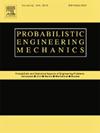Stochastic dynamic response analysis via dimension-reduced probability density evolution equation (DR-PDEE) with enhanced tail-accuracy
IF 3
3区 工程技术
Q2 ENGINEERING, MECHANICAL
引用次数: 0
Abstract
The stochastic dynamic analysis of high-dimensional nonlinear systems is a critical concern in engineering fields, especially when considering the reliability analysis of low-probability events. To address this challenge, the dimension-reduced probability density evolution equation (DR-PDEE) method has recently emerged as a promising tool. The DR-PDEE is the analytical governing equation for the probability density function (PDF) evolution of any path-continuous stochastic process. For a single response quantity of interest in a multi-dimensional nonlinear dynamic system, the corresponding DR-PDEE is merely a one- or two-dimensional partial differential equation. After estimating the intrinsic drift coefficient (IDC) in the DR-PDEE from sample data, this equation can be easily solved with rather high accuracy. However, if only a limited number of deterministic analyses are affordable, there is usually no sample information for the tail estimation of the IDC, resulting in an inaccurate PDF solution in the tail. In this work, a scheme is tailored for the DR-PDEE to further enhance its tail accuracy. Specifically, to increase the occurrence probability of tail samples, an additional set of samples is obtained by simply magnifying the excitation intensity of the system. Then, at each time step, samples in the response tail from this additional set are identified. By merging these samples with samples from the original system, a better IDC estimation in the tail is achieved. Several numerical examples are investigated to validate the effectiveness of the proposed DR-PDEE method. Comparisons with MCS and the classical DR-PDEE method show that the proposed scheme improves the accuracy and robustness of the PDF results in the tail.
求助全文
约1分钟内获得全文
求助全文
来源期刊

Probabilistic Engineering Mechanics
工程技术-工程:机械
CiteScore
3.80
自引率
15.40%
发文量
98
审稿时长
13.5 months
期刊介绍:
This journal provides a forum for scholarly work dealing primarily with probabilistic and statistical approaches to contemporary solid/structural and fluid mechanics problems encountered in diverse technical disciplines such as aerospace, civil, marine, mechanical, and nuclear engineering. The journal aims to maintain a healthy balance between general solution techniques and problem-specific results, encouraging a fruitful exchange of ideas among disparate engineering specialities.
 求助内容:
求助内容: 应助结果提醒方式:
应助结果提醒方式:


